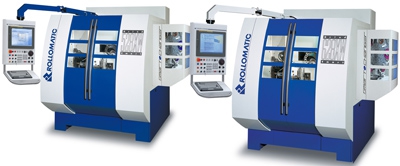
Anyone who knows Rollomatic is familiar with their reputation for grinding high-precision tools with the smallest diameters. However, the GrindSmart 528XW and GrindSmart 628XW now offer proof that Swiss precision can also be found outside of the micro-world. These tool grinders can now be used to effectively produce drilling or milling tools with diameters of up to 20mm. In today's manufacturing environment, production methods such as high-speed machining require extremely powerful tools that provide ultra-high quality and precision. Here, solid carbide tools with diameters of up to 20mm must often meet the same tight tolerances as their counterparts from the micro-sized segment.
"We are mainly known in the market for our microtool grinding machines. But we can also do larger diameters: Thanks to the new directly-driven grinding spindle with its doubled driving power as well as a high-efficiency coolant system, it is now equally possible to grind solid carbide metal-cutting tools with diameters of up to 20mm," explains Jean-Charles Marty, Product Manager at Rollomatic SA.
Even more important than the increased horsepower of the new grinding spindle (standard on both the GrindSmart 528XW and GrindSmart 628XW models) is the drive technology, which offers high torque in the lower RPM range while remaining constant as speed increases. Having high torque available at low speed as well as throughout the RPM range is decisive in increasing the power, "which also makes the machines suitable for depth grinding with large tool diameters," adds Jean-Charles Marty.
A major innovation of the GrindSmart XW series is the SmartChanger XW automated grinding wheel changer for up to six wheel flanges, each with up to four grinding wheels. This allows for even greater flexibility in the production of complex tools or in the rapid changing between larger and smaller batches. Together with the powerful programming software VirtualGrind Pro, high-performance tools such as molding tools, combination tools, standard tools, and many other variants can be ground in next to no time at all. For the GrindSmart XW series, Rollomatic has re-designed the wheel flange, which is now fully HSK50-compatible.
"By means of a special device for the SmartChanger XW, we can allow the user to adjust both the grinding wheels as well as the corresponding coolant nozzles outside the machine," explains Jean-Charles Marty.
This means that production can continue uninterrupted. In addition to this, optimal cooling at the grinding point is always ensured thanks to an improved, more efficient coolant supply system. After a specific number of grinding procedures, the carbide metal residues on the grinding wheel must be removed by a "sticking" process in order for the diamond wheel particles to once again cut freely. "What most tool manufacturers still do manually, our StickSmart option can now do fully automatically at defined intervals," declares Jean-Charles Marty.
This protects the grinding wheel, maintains the high precision, and reduces the spindle load significantly. Thanks to a universal tool headstock, the GrindSmart XW models are compatible with the standard clamping systems, including Nann and Schaublin.
Jean-Charles Marty: "With the new tool spindle and the reworked spindle guide system, concentricity tolerances in the µm range can be complied with, even in large tools."
Two models are offered with the SmartChanger XW grinding wheel changer: The GrindSmart 628XW is a 6-axis tool grinding center capable of meeting the demands in the grinding of complex and ultra-high-precision, high-performance tools with diameters of 0.10mm to 20mm. While the GrindSmart 528XW is ideal for anyone looking for a capable, do-it-all machine at an attractive price. This 5-axis machine is suitable for tools with diameters of 1.0mm to 20mm.
"With both grinding machines, we can cover the majority of challenging grinding tasks and also offer our customers larger tool dimensions with the usual Rollomatic precision," claims Jean-Charles Marty.
Contact Details
Related Glossary Terms
- coolant
coolant
Fluid that reduces temperature buildup at the tool/workpiece interface during machining. Normally takes the form of a liquid such as soluble or chemical mixtures (semisynthetic, synthetic) but can be pressurized air or other gas. Because of water’s ability to absorb great quantities of heat, it is widely used as a coolant and vehicle for various cutting compounds, with the water-to-compound ratio varying with the machining task. See cutting fluid; semisynthetic cutting fluid; soluble-oil cutting fluid; synthetic cutting fluid.
- gang cutting ( milling)
gang cutting ( milling)
Machining with several cutters mounted on a single arbor, generally for simultaneous cutting.
- grinding
grinding
Machining operation in which material is removed from the workpiece by a powered abrasive wheel, stone, belt, paste, sheet, compound, slurry, etc. Takes various forms: surface grinding (creates flat and/or squared surfaces); cylindrical grinding (for external cylindrical and tapered shapes, fillets, undercuts, etc.); centerless grinding; chamfering; thread and form grinding; tool and cutter grinding; offhand grinding; lapping and polishing (grinding with extremely fine grits to create ultrasmooth surfaces); honing; and disc grinding.
- grinding wheel
grinding wheel
Wheel formed from abrasive material mixed in a suitable matrix. Takes a variety of shapes but falls into two basic categories: one that cuts on its periphery, as in reciprocating grinding, and one that cuts on its side or face, as in tool and cutter grinding.
- milling
milling
Machining operation in which metal or other material is removed by applying power to a rotating cutter. In vertical milling, the cutting tool is mounted vertically on the spindle. In horizontal milling, the cutting tool is mounted horizontally, either directly on the spindle or on an arbor. Horizontal milling is further broken down into conventional milling, where the cutter rotates opposite the direction of feed, or “up” into the workpiece; and climb milling, where the cutter rotates in the direction of feed, or “down” into the workpiece. Milling operations include plane or surface milling, endmilling, facemilling, angle milling, form milling and profiling.
- wheel flange
wheel flange
Metal plate inside the grinding-wheel hole that allows the wheel to be mounted on a spindle.







